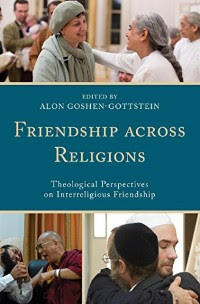Friendship Across Religions: Theological Perspectives on Interreligious Friendship

We are proud to announce that the third volume of the Interreligious Reflections series, “Friendship Across Religions: Theological Perspectives on Interreligious Friendship,” published by Lexington Press is now available. If you would like to purchase your copy, please click on the offer below:
In March, 2012, members of the Elijah Board of World Religious Leaders gathered in Oxford to discuss the question of Interreligious Friendship. One of the things that characterizes the Elijah Board of World Religious Leaders is the deep bonds of friendship that have developed between members. While it may seem obvious that forming friendships with people from different religions can be both a prelude to dialogue and an outcome of it, we should not ignore the obstacles to or, at least, warnings against such friendships that all our religious traditions include. Religious leaders and scholars are intensely aware of such concerns, so examining the teachings of each tradition that can impede friendships across religions and finding the theological support for such relationships, was a task that demanded our attention. As one of the scholars in our think-tank, an author of the Hindu chapter in the book, Prof Anantanand Rambachan said, in interreligious dialogue, practice often runs ahead of theory. This was an opportunity to explore and apply the theory to our practice.
The Elijah volume clarifies that by “friendship” the authors are referring to a relationship that goes beyond casual acquaintance; they are intimate and above all spiritual and transformative. The special kind of interreligious friendship that is the primary concern of the book is the kind of friendship that consciously engages the religious identity, experience and ideals of the participants. It is a friendship that revolves around the core of their respective spiritual lives, thereby making their friendship an integral component of each of their spiritual lives. While at times we may need to justify even the most fundamental or general friendship with members of other religions, the greater challenge, and greater promise, lie in those special friendships that are forms of spiritual friendship, practiced across religions.
The volume concludes with the manifesto on Interreligious Friendship that can be found here
To read a summary of the contribution of our authors from six different traditions, read on:
Alon Goshen-Gottstein
 The opening chapter identifying the key dimensions of interreligious friendship is authored by Elijah Executive Director, Alon Goshen-Gottstein. Drawing on the work of all the authors, he is able to distinguish friendship from other relationships. He begins by describing the foundations of the relationship, commonality of purpose, then speaks about practical collaboration. The next element he discusses is love and its place in changing the relationship from a utilitarian one to a genuine friendship. Trust then develops. Finally, the partners in a true interreligious friendship experience resonance of being. Goshen-Gottstein summarises the benefits of interreligious friendships to which all the authors allude. Interfaith friendships can give rise to at least three distinct but inter-related goods that intra-faith friendships are less suited to produce.
The opening chapter identifying the key dimensions of interreligious friendship is authored by Elijah Executive Director, Alon Goshen-Gottstein. Drawing on the work of all the authors, he is able to distinguish friendship from other relationships. He begins by describing the foundations of the relationship, commonality of purpose, then speaks about practical collaboration. The next element he discusses is love and its place in changing the relationship from a utilitarian one to a genuine friendship. Trust then develops. Finally, the partners in a true interreligious friendship experience resonance of being. Goshen-Gottstein summarises the benefits of interreligious friendships to which all the authors allude. Interfaith friendships can give rise to at least three distinct but inter-related goods that intra-faith friendships are less suited to produce.
(1) Interfaith friendships can give us a better, fairer understanding of other faiths through interaction with their concrete instantiations in the lives of our friends. Interfaith friendships, that is, can help us avoid prejudice.
(2) Interfaith friendships can lead us to a clearer and enriched understanding of our own faith.
(3) Interfaith friendships can develop our ability to authentically articulate our faith to others.
Thus, interreligious friendship is considered as a means for gaining better understanding of self and other. These conclusions are reached to varying degrees in all the successive chapters. (Stephen Murray Butler provides a summary in the volume.) In his chapter on Judaism, Alon Goshen-Gottstein he points out that that there are no Jewish tractates devoted to friendship, nor are there extended discussions of friendship and its virtues within the commentarial tradition, nor did any of the systematic tractates on key philosophical issues deal with friendship. In the Rabbinic tradition, the key context wherein friendship is understood is Torah study, leading to the juxtaposition of teacher and friend. However, the spiritual literature of Judaism goes beyond viewing friendship as an instrument for Torah study, and understands friendship in relation to the divine. The basis for a theology of friendship is found in the close association of the friend and God. The author notes the impossibility of cultivating friendship under conditions of persecution, forced conversion, repeated expulsion, abuse and fear that has characterized so much of Jewish history. Goshen-Gottstein suggests that Judaism seems to only be ready at this point in history for the kind of interreligious friendship that is based on practical collaboration, serving the common purposes of daily existence of the community and the individual. Yet, with theoretical reflection and education, he believes it will be possible to cultivate interreligious friendships and even the more intimate form of spiritual friendship, based on the principle of love which is so central to Judaism.
Meir Sendor writes a (Jewish) response to Alon Goshen-Gottstein, in which he acknowledges the latter’s analysis concerning the Halakhah’s discouragement of interfaith relations, the lack of genuine cross-religious relationships recorded or memorialized in the Jewish tradition, and reluctance to over-idealize a model relationship between a Jew and someone of another religious tradition. However, Sendor argues that there is one unusual and exceptional interreligious friendship described in the Talmud and midrashic literature: the close friendship between the scholar and political leader of second century Judea, Rabbi Yehudah ha- Nasi and the Roman Emperor Antoninus. In this interreligious friendship, there is a robust and healthy give-and-take on a range of personal, communal and intellectual issues. Sendor says, it leaves open the possibility that certain unique individuals, secure enough in their religious identity, of strong mind and open heart, could embrace such a friendship, in all its complexity, with the assent of the tradition. Authentic friendship welcomes difference and distance, thereby enabling the discovery of the other as other and all the more so as friend, which lays the ground for the possibility of real interreligious friendship.
Miroslav VolfAnchor: test
 Miroslav Volf and Ryan McAnnally- Linz address the question of interfaith friendships not merely as Christian theologians discussing a theological issue, but an issue that they acknowledge also has personal, social, and spiritual dimensions. Among the primary questions that they endeavor to address are: Do interfaith friendships put the Christians’ faithfulness or theological orthodoxy at risk? Do they offer any goods that distinguish them from friendships with other Christians? Should a Christian try to convert her friends from other traditions to her faith? How deep can a friendship go if the friends do not share a vision of the ultimate end of life? The authors summarize arguments within Christianity against supporting interfaith friendships, including the problems of teleology, difference, evangelism and frank speech, and identity. The authors then point out that there is another stream of sources in the Christian scriptures which may nourish Christian understandings of friendship and may promote interreligious friendship. They name four considerations: (1) Interfaith friendships must not ignore the friends’ faiths or flatten out the differences between them if they are to yield their rich goods; (2) Christian education should emphasize personal contact with members of other faiths and intentionally create spaces for the sort of informal interaction that can foster friendships; (3) Christian should welcome both shared projects with people of other faiths aimed at provisional goals and the friendships that are likely to grow out of such projects; and (4) the cultivation of interfaith friendships must not be a mere tactic in evangelization. Johann M. Vento offers a response to Miroslav Volf’s and Ryan McAnnally-Linz’s treatment of inter-religious friendship in Christian perspective, highlighting the concept of sacramentality as another resource within the Christian tradition beyond the biblical and philosophical focus of the previous essay. Vento affirms that deep, intimate, spiritual inter- religious friendships are sacramental: experiences of God’s grace which transform, heal, and nurture those in the path of holiness. By thinking of inter- religious friendships as sacramental, it is possible to shift the boundaries and alienating differences toward becoming sites of bonding, love, and trust. Vento argues that inter-religious friendships are, for the participants themselves and potentially for their faith communities, powerful sacramental signs and transformative experiences of God, who transcend all of our boundaries and heals all forms of alienation. Indeed, in the body of inter-religious friendship, a word of God may be experienced in a unique and profound way.
Miroslav Volf and Ryan McAnnally- Linz address the question of interfaith friendships not merely as Christian theologians discussing a theological issue, but an issue that they acknowledge also has personal, social, and spiritual dimensions. Among the primary questions that they endeavor to address are: Do interfaith friendships put the Christians’ faithfulness or theological orthodoxy at risk? Do they offer any goods that distinguish them from friendships with other Christians? Should a Christian try to convert her friends from other traditions to her faith? How deep can a friendship go if the friends do not share a vision of the ultimate end of life? The authors summarize arguments within Christianity against supporting interfaith friendships, including the problems of teleology, difference, evangelism and frank speech, and identity. The authors then point out that there is another stream of sources in the Christian scriptures which may nourish Christian understandings of friendship and may promote interreligious friendship. They name four considerations: (1) Interfaith friendships must not ignore the friends’ faiths or flatten out the differences between them if they are to yield their rich goods; (2) Christian education should emphasize personal contact with members of other faiths and intentionally create spaces for the sort of informal interaction that can foster friendships; (3) Christian should welcome both shared projects with people of other faiths aimed at provisional goals and the friendships that are likely to grow out of such projects; and (4) the cultivation of interfaith friendships must not be a mere tactic in evangelization. Johann M. Vento offers a response to Miroslav Volf’s and Ryan McAnnally-Linz’s treatment of inter-religious friendship in Christian perspective, highlighting the concept of sacramentality as another resource within the Christian tradition beyond the biblical and philosophical focus of the previous essay. Vento affirms that deep, intimate, spiritual inter- religious friendships are sacramental: experiences of God’s grace which transform, heal, and nurture those in the path of holiness. By thinking of inter- religious friendships as sacramental, it is possible to shift the boundaries and alienating differences toward becoming sites of bonding, love, and trust. Vento argues that inter-religious friendships are, for the participants themselves and potentially for their faith communities, powerful sacramental signs and transformative experiences of God, who transcend all of our boundaries and heals all forms of alienation. Indeed, in the body of inter-religious friendship, a word of God may be experienced in a unique and profound way.
Timothy Gianotti
 Timothy J. Gianotti attempts to formulate a faithful and intellectually honest Muslim framework for building friendships between individuals of different faith traditions, beginning with the Qur’ānically-identified traditions of Judaism and Christianity and expanding beyond them to include other faith traditions. Gianotti explores the understanding of friendship within the Qur’ānic and prophetic foundations, specifically seeing friendship as “brotherhood” or fellowship. He explains that the bond of belief, containing a shared sense of ultimate concern or ultimate purpose, teleology, is Qur’ānically understood to be the most meaningful foundation of friendship. This concept of brotherly or sisterly friendship does not always mean easy agreement, for love, mutual concern, and truthfulness require mutual interrogation and challenge.
Timothy J. Gianotti attempts to formulate a faithful and intellectually honest Muslim framework for building friendships between individuals of different faith traditions, beginning with the Qur’ānically-identified traditions of Judaism and Christianity and expanding beyond them to include other faith traditions. Gianotti explores the understanding of friendship within the Qur’ānic and prophetic foundations, specifically seeing friendship as “brotherhood” or fellowship. He explains that the bond of belief, containing a shared sense of ultimate concern or ultimate purpose, teleology, is Qur’ānically understood to be the most meaningful foundation of friendship. This concept of brotherly or sisterly friendship does not always mean easy agreement, for love, mutual concern, and truthfulness require mutual interrogation and challenge.
Gianotti maintains that if we agree that the Qur’ānically-described purpose and function of inter-religious friendship is to “test” us in what we have been given –to challenge us to more deeply explore and more fully manifest what we believe to be the essential teachings and treasures of our own faith – then it seems entirely possible for this purpose to be fulfilled as readily within Muslim-Buddhist or Muslim-Hindu friendships as it is within Muslim-Jewish and Muslim-Christian friendships. However, there are significant obstacles to inter-religious friendships, which Gianotti names as a xenophobia that springs from historical and cultural factors which might outweigh or overshadow theological considerations: colonization, occupation, and political, economic, and cultural domination by western, nominally Christian nations. The rejection of western hegemony and reassertion of a somewhat puritanical Muslim identity has tremendous appeal in many parts of the traditionally Muslim world, where the West, with its inescapable modernizing, secularizing, and globalizing influences, is viewed with anger and tremendous suspicion. This, of course, affects Muslim relations with Christians and Jews and Hindus and other religious communities in their midst, communities that are suspected of harboring sympathies with the west or, worse, to have “sold out” to western, secularist ideals.
These cultural and political factors thus make the question of inter-religious friendship a complex and controversial one in the contemporary world.
Anantanand Rambachan
 In the vision of the Hindu sacred text, the Bhagavadgita, one who has attained the ideal of friendship transcends the dualism of friend and enemy and sees all beings with the vision of friendship. Anantanand Rambachan says that such a person is free from hostile attitudes towards others and is described as “the same with reference to an enemy and friend, and in honor and disgrace.” The fulfillment of friendship in the Hindu tradition is the overcoming of the division of the world into friends and enemies, those who are loved and those who are hated and despised. At the heart of the ideal of an all-inclusive friendship is the teaching that the infinite brahman exists identically in all beings. Since the infinite is present in each being as the warp and woof of selfhood, to see the infinite in another is to see oneself in another. Friendship, in the highest sense, is the overcoming of alienation and estrangement from others through the recognition of one’s own Self, the infinite brahman, in the other.
In the vision of the Hindu sacred text, the Bhagavadgita, one who has attained the ideal of friendship transcends the dualism of friend and enemy and sees all beings with the vision of friendship. Anantanand Rambachan says that such a person is free from hostile attitudes towards others and is described as “the same with reference to an enemy and friend, and in honor and disgrace.” The fulfillment of friendship in the Hindu tradition is the overcoming of the division of the world into friends and enemies, those who are loved and those who are hated and despised. At the heart of the ideal of an all-inclusive friendship is the teaching that the infinite brahman exists identically in all beings. Since the infinite is present in each being as the warp and woof of selfhood, to see the infinite in another is to see oneself in another. Friendship, in the highest sense, is the overcoming of alienation and estrangement from others through the recognition of one’s own Self, the infinite brahman, in the other.
The principal obstacle to interreligious friendship, from the perspective of the Hindu tradition, is Hindus’ non-recognition of the culturally and socially constructed nature of the many identities that they profess and their tendency to regard these as absolute and unchanging. Such identities may be constructed on the basis of race, ethnicity, culture and, in the case of many Hindus, caste.
The Hindu religious tradition recognizes that religious boundaries are porous and fluid, and this porous quality tends to make interreligious friendships less problematic. There is no persistent and widespread negativization of the fact of religious diversity and no systematic effort at homogenization. Hindus tend, on the whole, to see religious diversity as naturally reflecting the diversity of human nature and experience, whereas other identities for as the caste identity act as a barrier.
Rambachan delves deeply into the relationship of Mahatma Gandhi and C.F. Andrews as a means of exemplifying the promises and challenges and interreligious friendships. There are several lessons that Rambachan mines from this particular interreligious friendship which may be generalized. In the case of friendship across religious traditions, common doctrine and ritual may not be sources for a shared identity that enable the flourishing of identification with others. Gandhi and Andrews discovered their common humanity and shared identity by\ recognizing in one another the earnest seeker and the servant of the poor. This found expression in a profound care for each other.
Maria Reis Habito
 Authors of the chapter on Buddhism, Maria Reis Habito and Ruben L.F. Habito argue that while spiritual friendship within one’s own religious community is of the utmost importance in deepening one’s understanding of the ultimate purpose of life and putting that understanding into practice, friendship outside of one’s tradition may serve more powerfully in this regard by shedding light on the understanding of oneself and one’s own religious tradition, as it does on one’s understanding of the Religious Other. They assert that mutual rapport and spiritual friendship with non-Buddhists who are of admirable character and who exhibit exemplary spiritual qualities may inspire and challenge a Buddhist all the more to live in an authentic way as befitting one’s own (Buddhist) tradition that professes to be a path of awakening grounded in wisdom and compassion. Such admirable persons, with whom a Buddhist may be privileged to enter into bonds of friendship, may be considered as members of that person’s Sangha, though they themselves may not identify as Buddhist in the formal sense, as they belong to the wider community of support that enables a practitioner to deepen in the Buddhist path.
Authors of the chapter on Buddhism, Maria Reis Habito and Ruben L.F. Habito argue that while spiritual friendship within one’s own religious community is of the utmost importance in deepening one’s understanding of the ultimate purpose of life and putting that understanding into practice, friendship outside of one’s tradition may serve more powerfully in this regard by shedding light on the understanding of oneself and one’s own religious tradition, as it does on one’s understanding of the Religious Other. They assert that mutual rapport and spiritual friendship with non-Buddhists who are of admirable character and who exhibit exemplary spiritual qualities may inspire and challenge a Buddhist all the more to live in an authentic way as befitting one’s own (Buddhist) tradition that professes to be a path of awakening grounded in wisdom and compassion. Such admirable persons, with whom a Buddhist may be privileged to enter into bonds of friendship, may be considered as members of that person’s Sangha, though they themselves may not identify as Buddhist in the formal sense, as they belong to the wider community of support that enables a practitioner to deepen in the Buddhist path.
Eleanor Nesbitt
 At the heart of Sikh life is the Guru Granth Sahib, the Sikh scripture. Eleanor Nesbitt argues in her chapter that the Gurus’ insights unquestionably support friendships between humans of whatever community, although in practice in the Punjabi cultural matrix of Sikh tradition, social divides such as castes are more problematic to friendship than religious faith or identification. Sikhs assume that religions guide their adherents to the same point – union with the divine, via moral life and divine grace. Nesbitt provides several historical cases of Sikh friendship with non-Sikhs, but also explores the main obstacles to friendship: inter-communal bloodshed and trust issues due to history and politics. She argues that within the Sikh community the issue of inter-religious friendship highlights the dynamic tension between, on the one hand, the theological universality expressed in the Guru Granth Sahib together with its emphasis on a loving relationship between the Divine and the devotee and, on the other hand, Sikh responses to social and political developments, from the Gurus’ times to the present. Another concern is the gender imbalance in what Nesbitt has reported and discussed: all the human Gurus and all the other poets whose work is included in the Guru Granth Sahib were men. While some women played significant historical roles, Sikh women authors only began to emerge in the twentieth century. All of the instances that Nesbitt cites of friendship between Sikh and non-Sikh were friendships between men. (This is true throughout the volume.)
At the heart of Sikh life is the Guru Granth Sahib, the Sikh scripture. Eleanor Nesbitt argues in her chapter that the Gurus’ insights unquestionably support friendships between humans of whatever community, although in practice in the Punjabi cultural matrix of Sikh tradition, social divides such as castes are more problematic to friendship than religious faith or identification. Sikhs assume that religions guide their adherents to the same point – union with the divine, via moral life and divine grace. Nesbitt provides several historical cases of Sikh friendship with non-Sikhs, but also explores the main obstacles to friendship: inter-communal bloodshed and trust issues due to history and politics. She argues that within the Sikh community the issue of inter-religious friendship highlights the dynamic tension between, on the one hand, the theological universality expressed in the Guru Granth Sahib together with its emphasis on a loving relationship between the Divine and the devotee and, on the other hand, Sikh responses to social and political developments, from the Gurus’ times to the present. Another concern is the gender imbalance in what Nesbitt has reported and discussed: all the human Gurus and all the other poets whose work is included in the Guru Granth Sahib were men. While some women played significant historical roles, Sikh women authors only began to emerge in the twentieth century. All of the instances that Nesbitt cites of friendship between Sikh and non-Sikh were friendships between men. (This is true throughout the volume.)
In the following chapter, Balwant Singh Dhillon argues that Sikh concepts of inter-religious friendships are deeply rooted in the religious and historical experiences of Sikh Gurus, noting that Sikh relations with others has been marked by amity, goodwill, and friendship. The basic principles of Guru Nanak’s message are the unity of the Godhead and the brotherhood and sisterhood of humankind, the two principles which form the bedrock of Sikh perspective on friendship. Teaching the Oneness of God who is transcendental as well as immanent, creator as well as prevalent in creation, Guru Nanak and the Sikh gurus who followed him articulated a God free from sectarian affiliations. The Sikh concept of God does not belong to any particular race, community, or gender, but is the common parent of all human beings, and thus no one religion can lay exclusive claim over the revelation of God.

